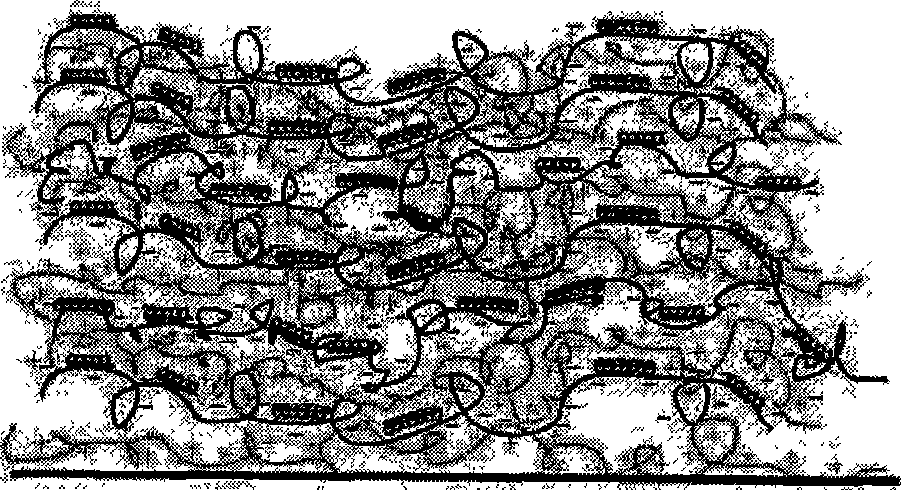Compound film enhanced by inclusion complex of ring molecule and polymer and preparation method thereof
A technology of cyclic molecules and polymers, applied in the field of layer-by-layer self-assembled supramolecular multilayer films, can solve the problems of interface incompatibility, weak interface adhesion, damage to the mechanical properties of bionic composite films, etc., and achieve strong specificity , stable structure, and easy phase separation of the substrate medium
- Summary
- Abstract
- Description
- Claims
- Application Information
AI Technical Summary
Problems solved by technology
Method used
Image
Examples
Embodiment 1
[0030] Carboxy-terminated polyethylene glycol (molecular weight: 10,000) and chitosan (molecular weight: 800,000) were dissolved in water to form 9% and 0.1% solutions, and α-cyclodextrin was dissolved in water to form a 2% solution. At room temperature, first immerse the clean base mica sheet in the chitosan solution, take out the mica sheet after 20 minutes, and wash it twice in deionized water to remove excess chitosan molecules. At this time, a layer of almost monomolecular layer of chitosan molecules; then the mica sheet is immersed in the solution of carboxypolyethylene glycol, and after 20 minutes, the mica sheet is taken out and washed twice in deionized water to remove excess polyethylene glycol molecules. Alcohol molecules will be adsorbed on chitosan to form a polyethylene glycol layer; then the mica sheet is immersed in an aqueous solution of α-cyclodextrin, and washed twice in deionized water after 2 hours, because α-cyclodextrin will interact with Polyethylene gl...
Embodiment 2
[0032] Histone grafted with polypropylene glycol (molecular weight: 300,000) was dissolved in water to form a 0.5% solution, and β-cyclodextrin was dissolved in water to form a 1% solution. At room temperature, first immerse the clean cellulose acetate basement membrane in the polypropylene glycol-histone solution, take out the basement membrane after 20 minutes, and wash twice in deionized water to remove excess polypropylene glycol-histone, at this time, the basement membrane will adsorb A layer of polypropylene glycol-histone molecules; then immerse the basement membrane in β-cyclodextrin aqueous solution, and wash twice in deionized water after 2 hours, because β-cyclodextrin will bind with polypropylene glycol-histone molecules The polypropylene glycol graft chain produces selective inclusion, so the substrate will be discontinuously covered with a layer of inclusion, forming an inclusion layer, and an assembly cycle ends. When the above assembly is repeated, since histon...
Embodiment 3
[0034] Dissolve polyethylene glycol-polyvinylimide block copolymer (molecular weight: 20,000) and polyvinylpyridine (molecular weight: 5,000) respectively in dimethyl sulfoxide to make a 10% solution, α-cyclodextrin Dissolved in water to form a 3% solution. First immerse the clean silicon wafer in the polyvinylpyridine solution at 50°C, take out the silicon wafer after 20 minutes, wash twice in dimethyl sulfoxide to remove excess polyvinylpyridine, and at this time, a certain amount of polyvinylpyridine will be adsorbed on the silicon wafer. Layer polyethylene glycol-polyvinylimide molecules; then immerse the silicon wafer in the polyethylene glycol-polyvinylimide solution, take out the silicon wafer after 20 minutes, and wash twice in dimethyl sulfoxide Remove excess polyethylene glycol-polyvinylimide molecules, due to hydrogen bonding, a layer of polyethylene glycol-polyvinylimide molecules will be adsorbed on polyvinylpyridine; and then immerse the silicon wafer in α - In ...
PUM
 Login to View More
Login to View More Abstract
Description
Claims
Application Information
 Login to View More
Login to View More - R&D
- Intellectual Property
- Life Sciences
- Materials
- Tech Scout
- Unparalleled Data Quality
- Higher Quality Content
- 60% Fewer Hallucinations
Browse by: Latest US Patents, China's latest patents, Technical Efficacy Thesaurus, Application Domain, Technology Topic, Popular Technical Reports.
© 2025 PatSnap. All rights reserved.Legal|Privacy policy|Modern Slavery Act Transparency Statement|Sitemap|About US| Contact US: help@patsnap.com

